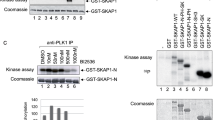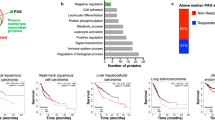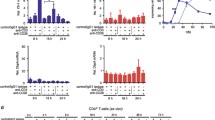Abstract
Background
Low levels of the cyclin-dependent kinase inhibitor p27Kip1 are associated with poor prognosis in cancer. It is unclear whether this is related strictly to p27Kip1-mediated cell cycle inhibition or to other, possibly extranuclear, roles of this protein. In this study, we examined p27Kip1 expression in quiescent and activated lymphocytes. T-cell membranes have been shown to possess sphingolipid and cholesterol-rich microdomains that are insoluble in non-ionic detergents. These “rafts” provide a scaffold for signaling proteins. Signal transduction coincides with coalescence of these microdomains into larger complexes.
Methods
Localization of p27Kip1 was studied by electron and confocal microscopy. Association of p27Kip1 with membrane microdomains in unstimulated and stimulated lymphocytes was determined using Western blots analysis of isolated membranes variably treated with detergents.
Results
We demonstrated that p27Kip1 was present in clusters associated with the plasma membrane in normal lymphocytes. The solubility profile of p27Kip1 in isolated membranes indicated that it was localized to raft structures. When lymphocytes were stimulated, however, p27Kip1 was excluded from aggregated raft complexes.
Conclusions
This study identifies, for the first time, the localization of p27 within a membrane microdomain associated with signaling. Because some cell surface signaling complexes lose p27Kip1 upon cellular activation, p27Kip1 may play a functional role in modulating membrane signaling.






Similar content being viewed by others
References
Porter PL, Malone KE, Heagerty PJ, et al. (1997) Expression of cell-cycle regulators p27Kip1 and cyclin E, alone and in combination, correlate with survival in young breast cancer patients [see comments]. Nat. Med. 3: 222–225.
Loda M, Cukor B, Tam SW, et al. (1997) Increased proteasome-dependent degradation of the cyclin-dependent kinase inhibitor p27 in aggressive colorectal carcinomas [see comments]. Nat. Med. 3: 231–234.
Lloyd RV, Erickson LA, Jin L, et al. (1999) p27kip1: a multifunctional cyclin-dependent kinase inhibitor with prognostic significance in human cancers. Am. J. Pathol. 154: 313–323.
Erlanson M, Portin C, Linderholm B, Lindh J, Roos G, Landberg G. (1998) Expression of cyclin E and the cyclin-dependent kinase inhibitor p27 in malignant lymphomasprognostic implications. Blood 92: 770–777.
Wang J, Walsh K. (1996) Resistance to apoptosis conferred by Cdk inhibitors during myocyte differentiation. Science 273: 359–361.
Eymin B, Haugg M, Droin N, Sordet O, Dimanche-Boitrel MT, Solary E. (1999) p27Kip1 induces drug resistance by preventing apoptosis upstream of cytochrome c release and procaspase-3 activation in leukemic cells. Oncogene 18: 1411–1418.
Katayose Y, Kim M, Rakkar AN, Li Z, Cowan KH, Seth P. (1997) Promoting apoptosis: a novel activity associated with the cyclin- dependent kinase inhibitor p27. Cancer Res. 57: 5441–5445.
Boussiotis VA, Freeman GJ, Taylor PA, et al. (2000) p27Kip1 functions as an anergy factor inhibiting interleukin 2 transcription and clonal expansion of alloreactive human and mouse helper T lymphocytes. Nat. Med. 6: 290–297.
Nagahara H, Vocero-Akbani AM, Snyder EL, et al. (1998) Transduction of full-length TAT fusion proteins into mammalian cells: TAT-p27Kip1 induces cell migration. Nat. Med. 4: 1449–1452.
Zabludoff SD, Csete M, Wagner R, Yu X, Wold BJ. (1998) p27Kip1 is expressed transiently in developing myotomes and enhances myogenesis. Cell Growth Differ. 9: 1–11.
Hauser PJ, Agrawal D, Flanagan M, Pledger WJ. (1997) The role of p27Kip1 in the in vitro differentiation of murine keratinocytes. Cell Growth Differ. 8: 203–211.
Kranenburg O, Scharnhorst V, Van der Eb AJ, Zantema A. (1995) Inhibition of cyclin-dependent kinase activity triggers neuronal differentiation of mouse neuroblastoma cells. J. Cell Biol. 131: 227–234.
Yaroslavskiy B, Watkins S, Donnenberg AD, Patton TJ, Steinman RA. (1999) Subcellular and cell-cycle expression profiles of CDK-inhibitors in normal differentiating myeloid cells. Blood 93: 2907–2917.
Masciullo V, Sgambato A, Pacilio C, et al. (1999) Frequent loss of expression of the cyclin-dependent kinase inhibitor p27 in epithelial ovarian cancer. Cancer Res. 59: 3790–3794.
Singh SP, Lipman J, Goldman H, et al. (1998) Loss or altered subcellular localization of p27 in Barrett’s associated adenocarcinoma. Cancer Res. 58: 1730–1735.
Sgambato A, Ratto C, Faraglia B, et al. (1999) Reduced expression and altered subcellular localization of the cyclin-dependent kinase inhibitor p27(Kip1) in human colon cancer. Mol. Carcinog. 26: 172–179.
Baldassarre G, Belletti B, Bruni P, et al. (1999) Overexpressed cyclin D3 contributes to retaining the growth inhibitor p27 in the cytoplasm of thyroid tumor cells. J. Clin. Invest. 104: 865–874.
Sanchez-Beato M, Camacho FI, Martinez-Montero JC, et al. (1999) Anomalous high p27/KIP1 expression in a subset of aggressive B-cell lymphomas is associated with cyclin D3 overexpression. p27/KIP1-cyclin D3 colocalization in tumor cells. Blood 94: 765–772.
Nourse J, Firpo E, Flanagan WM, et al. (1994) Interleukin-2-mediated elimination of the p27Kip1 cyclin-dependent kinase inhibitor prevented by rapamycin. Nature 372: 570–573.
Yaroslavskiy B, Watkins S, Donnenberg AD, Steinman RA. (1998) Alteration in subcellular localization of p27KIP1 in mononuclear cells stimulated with SEB or IL-2. Blood 92: 374a.
Pralle A, Keller P, Florin E, Simons K, Horber JK. (2000) Sphingolipid-cholesterol rafts diffuse as small entities in the plasma membrane of mammalian cells [In Process Citation]. J. Cell Biol. 148: 997–1008.
Brown DA, London E. (2000) Structure and function of sphingolipid- and cholesterol-rich membrane rafts. J. Biol. Chem. In Press
Hooper NM. (1999) Detergent-insoluble glycosphingolipid/cholesterol-rich membrane domains, lipid rafts and caveolae (review). Mol. Membr. Biol. 16: 145–156.
Lou Z, Jevremovic D, Billadeau DD, Leibson PJ. (2000) A balance between positive and negative signals in cytotoxic lymphocytes regulates the polarization of lipid rafts during the development of cell-mediated killing. J. Exp. Med. 191: 347–354.
Lin J, Weiss A, Finco TS. (1999) Localization of LAT in glycolipid-enriched microdomains is required for T cell activation. J. Biol. Chem. 274: 28861–28864.
Stolz DB, Jacobson BS. (1991) Macro- and microvascular endothelial cells in vitro: maintenance of biochemical heterogeneity despite loss of ultrastructural characteristics. In Vitro Cell. Dev. Biol. 27A: 169–182.
Chaney LK, Jacobson BS. (1983) Coating cells with colloidal silica for high yield isolation of plasma membrane sheets and identification of transmembrane proteins. J. Biol. Chem. 258: 10062–10072.
Rizzo MA, Shome K, Vasudevan C, et al. (1999) Phospholipase D and its product, phosphatidic acid, mediate agonist-dependent raf-1 translocation to the plasma membrane and the activation of the mitogen-activated protein kinase pathway. J. Biol. Chem. 274: 1131–1139.
Xavier R, Brennan T, Li Q, McCormack C, Seed B. (1998) Membrane compartmentation is required for efficient T cell activation. Immunity 8: 723–732.
Solomon KR, Mallory MA, Finberg RW. (1998) Determination of the non-ionic detergent insolubility and phosphoprotein associations of glycosylphosphatidylinositol-anchored proteins expressed on T cells. Biochem. J. 334: 325–333.
Janes PW, Ley SC, Magee AI. (1999) Aggregation of lipid rafts accompanies signaling via the T cell antigen receptor. J. Cell. Biol. 147: 447–461.
Fra AM, Williamson E, Simons K, Parton RG. (1994) Detergent-insoluble glycolipid microdomains in lymphocytes in the absence of caveolae. J. Biol. Chem. 269: 30745–30748.
Simons M, Friedrichson T, Schulz JB, Pitto M, Masserini M, Kurzchalia TV. (1999) Exogenous administration of gangliosides displaces GPI-anchored proteins from lipid microdomains in living cells. Mol. Biol. Cell. 10: 3187–3196.
Hooper NM, Turner AJ. (1988) Ectoenzymes of the kidney microvillar membrane. Differential solubilization by detergents can predict a glycosyl-phosphatidylinositol membrane anchor. Biochem. J. 250: 865–869.
Deckert M, Ticchioni M, Mari B, Mary D, Bernard A. (1995) The glycosylphosphatidylinositol-anchored CD59 protein stimulates both T cell receptor zeta/ZAP-70-dependent and -independent signaling pathways in T cells. Eur. J. Immunol. 25: 1815–1822.
Korty PE, Brando C, Shevach EM. (1991) CD59 functions as a signal-transducing molecule for human T cell activation. J. Immunol. 146: 4092–4098.
Montixi C, Langlet C, Bernard AM, et al. (1998) Engagement of T cell receptor triggers its recruitment to low-density detergent-insoluble membrane domains. Embo. J. 17: 5334–5348.
Stulnig TM, Berger M, Sigmund T, Raederstorff D, Stockinger H, Waldhausl W. (1998) Polyunsaturated fatty acids inhibit T cell signal transduction by modification of detergent-insoluble membrane domains. J. Cell. Biol. 143: 637–644.
Mukherjee S, Soe TT, Maxfield FR. (1999) Endocytic sorting of lipid analogues differing solely in the chemistry of their hydrophobic tails. J. Cell. Biol. 144: 1271–1284.
Nguyen DH, Hildreth JE. (2000) Evidence for budding of human immunodeficiency virus type 1 selectively from glycolipid-enriched membrane lipid rafts [In Process Citation]. J. Virol. 74: 3264–3272.
ter Haar E, Harrison SC, Kirchhausen T. (2000) Peptide-in-groove interactions link target proteins to the β-propeller of clathrin [see comments]. Proc. Natl. Acad. Sci. USA 97: 1096–1100.
Dell’Angelica EC, Klumperman J, Stoorvogel W, Bonifacino JS. (1998) Association of the AP-3 adaptor complex with clathrin. Science 280: 431–434.
Maizel A, Bensaude O, Prochiantz A, Joliot A. (1999) A short region of its homeodomain is necessary for engrailed nuclear export and secretion. Development 126: 3183–3190.
Tomoda K, Kubota Y, Kato J. (1999) Degradation of the cyclin-dependent-kinase inhibitor p27Kip1 is instigated by Jab1 [see comments]. Nature 398: 160–165.
Moffett S, Brown DA, Linder ME. (2000) Lipid-dependent targeting of G proteins into rafts. J. Biol. Chem. 275: 2191–2198.
Martens JR, Navarro-Polanco R, Coppock EA, et al. (2000) Differential targeting of Shaker-like potassium channels to lipid rafts. J. Biol. Chem. 275: 7443–7446.
Bruckner K, Pablo Labrador J, Scheiffele P, Herb A, Seeburg PH, Klein R. (1999) EphrinB ligands recruit GRIP family PDZ adaptor proteins into raft membrane microdomains. Neuron 22: 511–524.
Krauss K, Altevogt P. (1999) Integrin leukocyte function-associated antigen-1-mediated cell binding can be activated by clustering of membrane rafts. J. Biol. Chem. 274: 36921–36927.
Cheng PC, Dykstra ML, Mitchell RN, Pierce SK. (1999) A role for lipid rafts in B cell antigen receptor signaling and antigen targeting. J. Exp. Med. 190: 1549–1560.
Gaulin JF, Fiset A, Fortier S, Faure RL. (2000) Characterization of Cdk2-cyclin E complexes in plasma membrane and endosomes of liver parenchyma. Insulin-dependent Regulation [In Process Citation]. J. Biol. Chem. 275: 16658–16665.
Uren A, Jakus J, de Mora JF, et al. (1997) Carboxyl-terminal domain of p27Kip1 activates CDC2. J. Biol. Chem. 272: 21669–21672.
Acknowledgements
We thank Drs. Rebecca Hughey, Ora Weisz, and Candace Johnson for helpful discussions. We also thank Drs. Robert Getzenberg for TAFIID antibody, Penny Morel for lck antibody, and Rebecca Hughey for octylglucoside. This work was supported by a grant from the American Cancer Society (RPG-98-083) to R.A.S.
Author information
Authors and Affiliations
Corresponding author
Rights and permissions
About this article
Cite this article
Yaroslavskiy, B.B., Stolz, D.B., Watkins, S.C. et al. p27Kip1 Localizes to Detergent-insoluble Microdomains Within Lymphocyte Membranes. Mol Med 7, 49–58 (2001). https://doi.org/10.1007/BF03401838
Accepted:
Published:
Issue Date:
DOI: https://doi.org/10.1007/BF03401838




